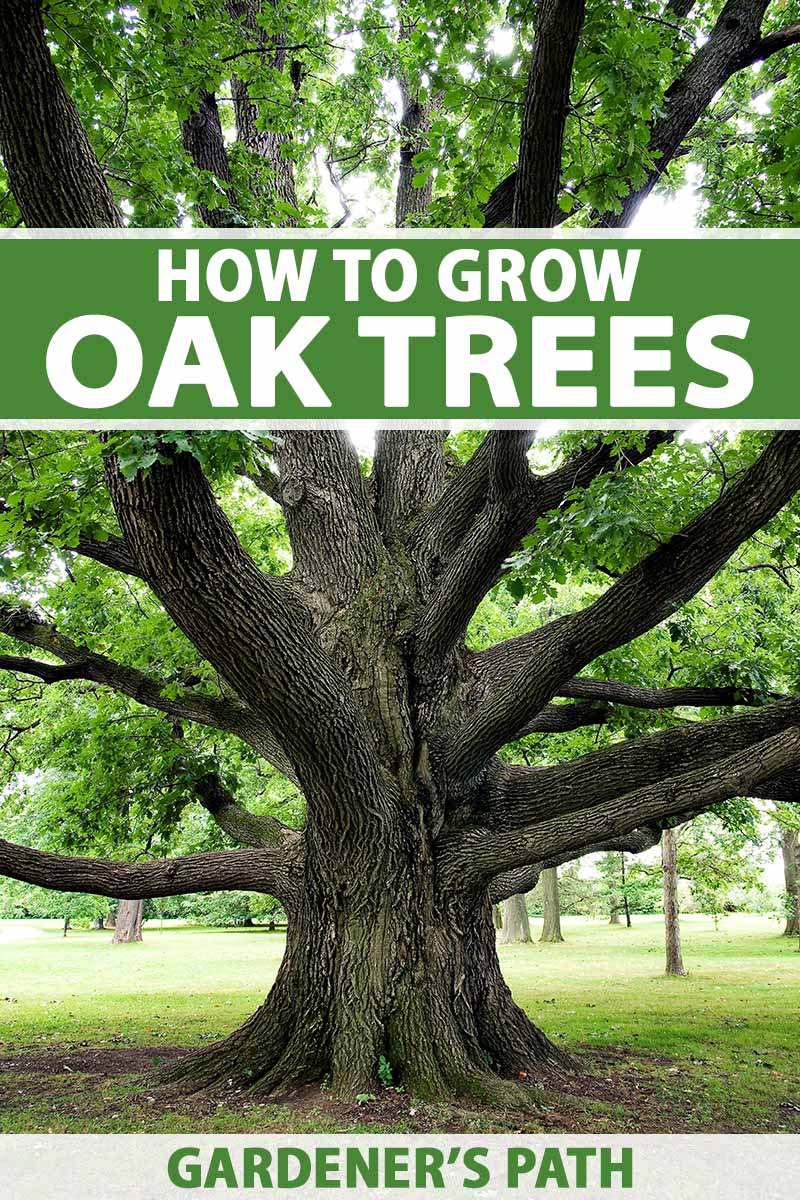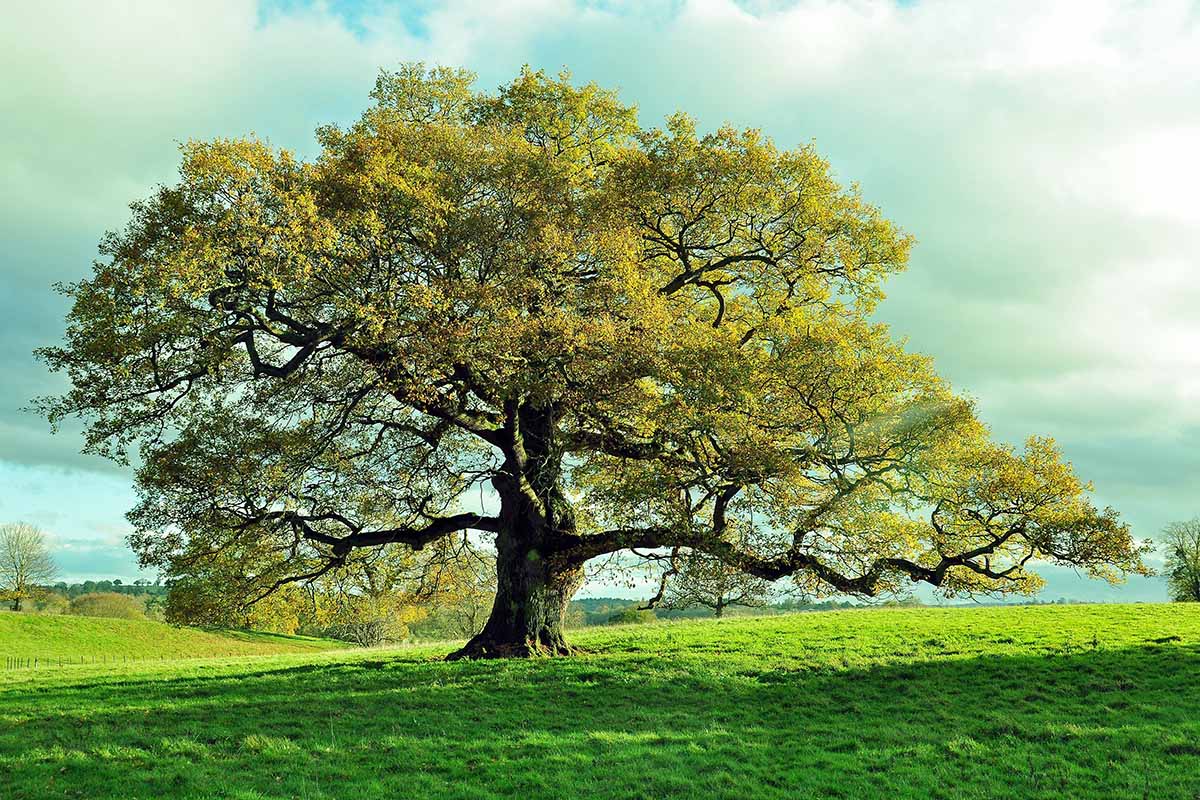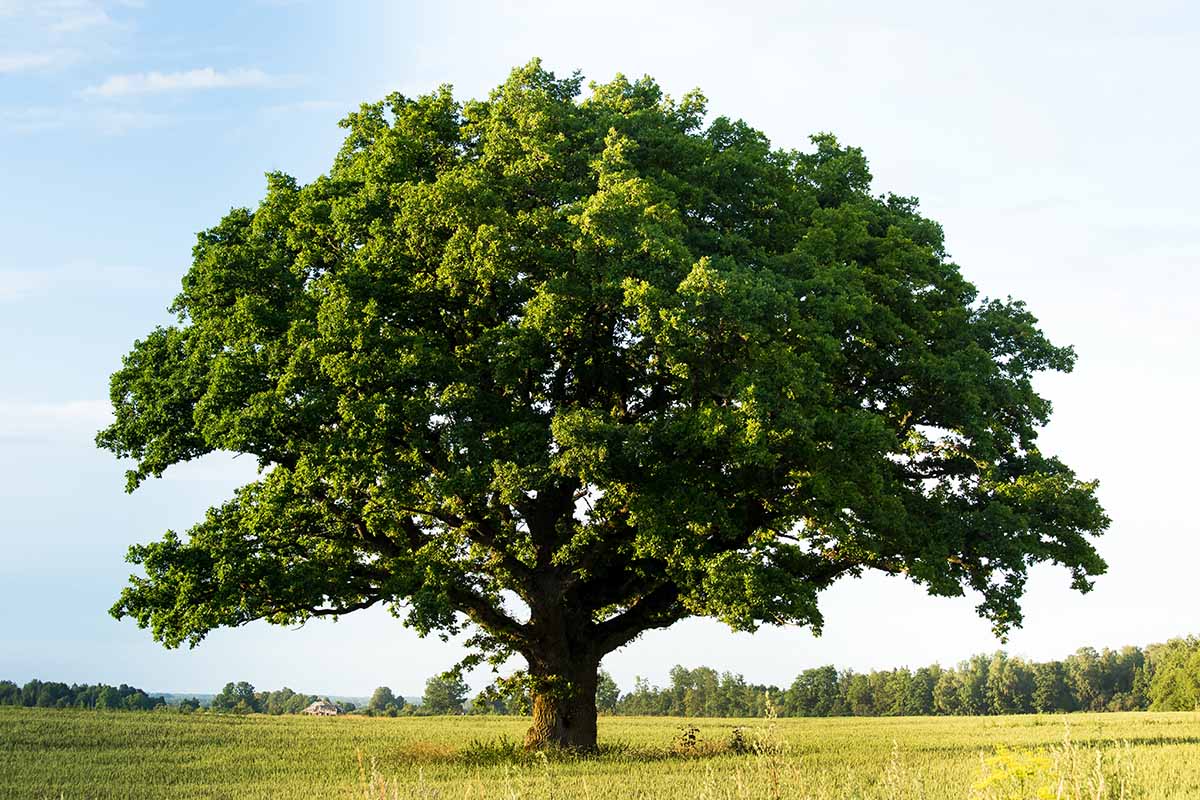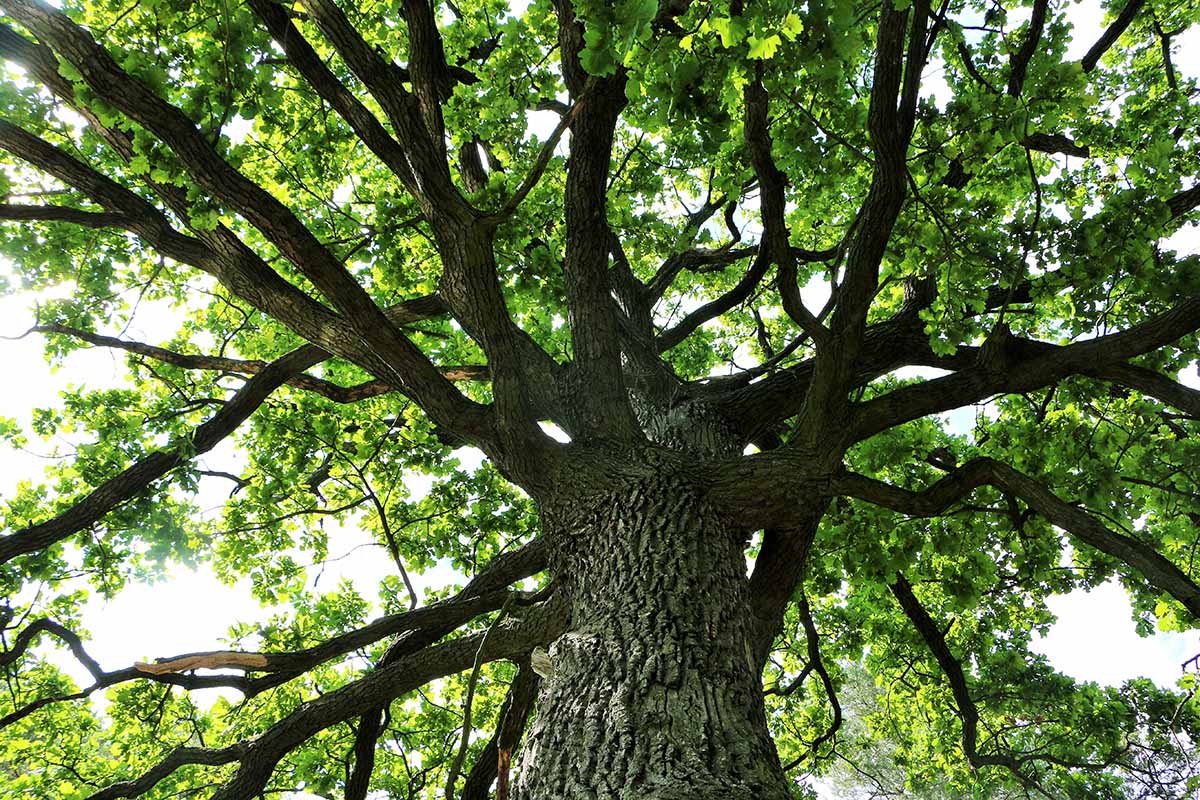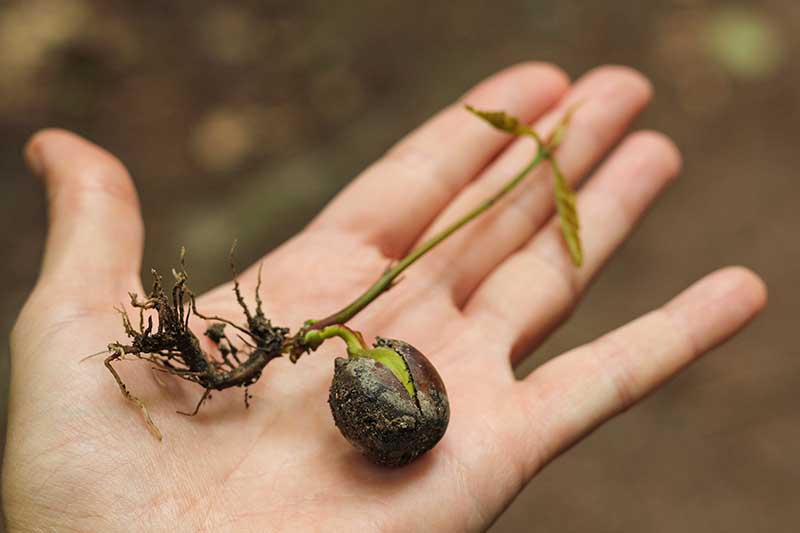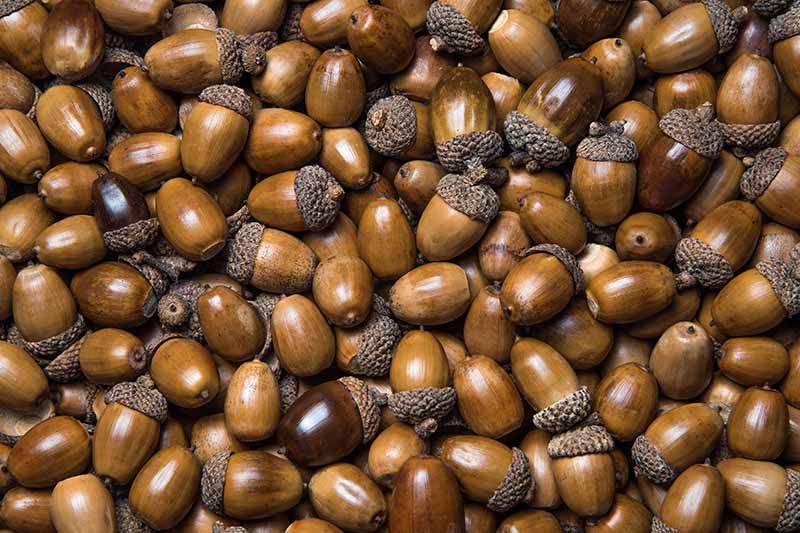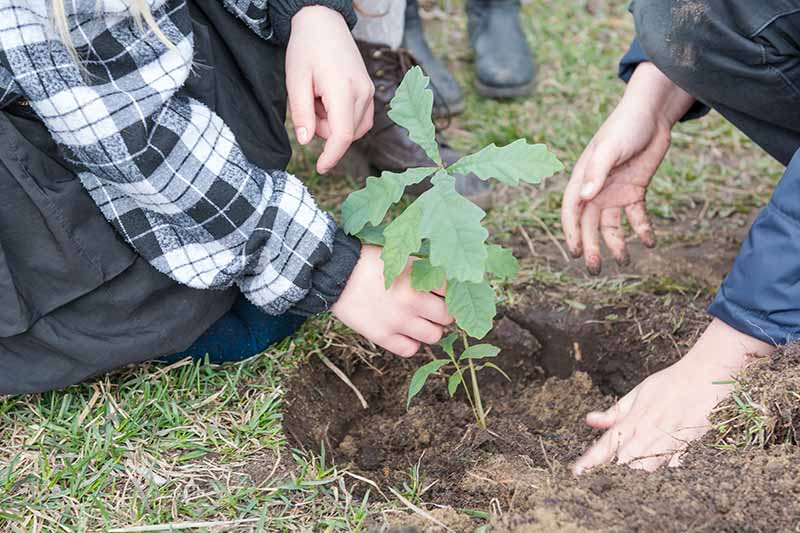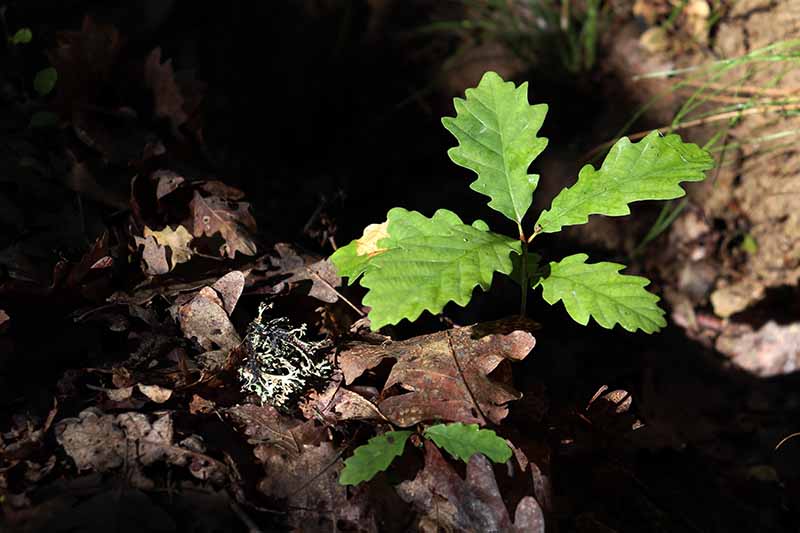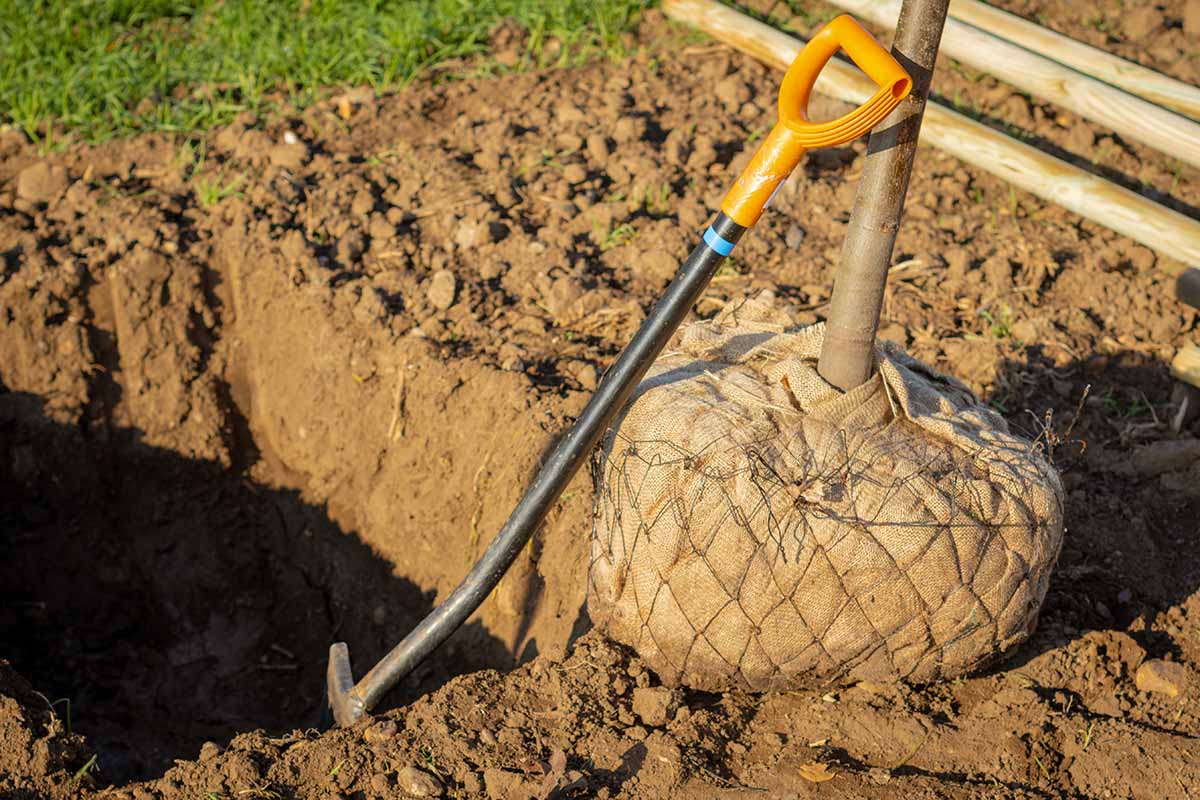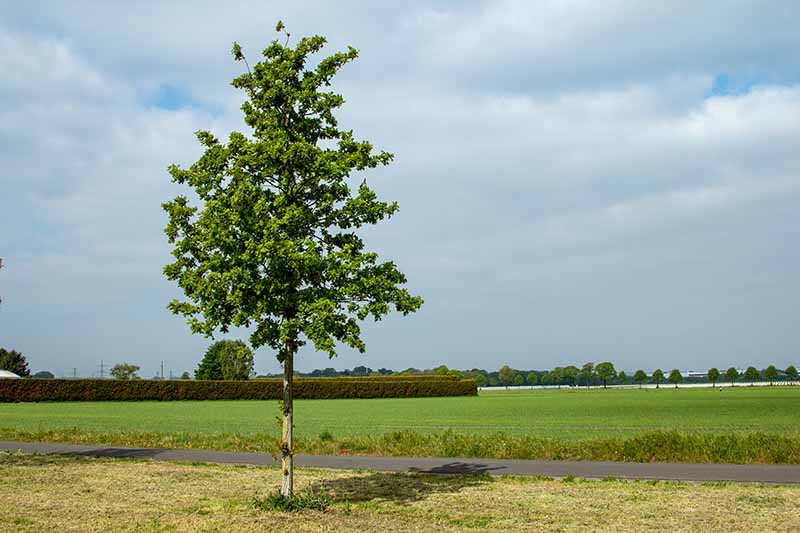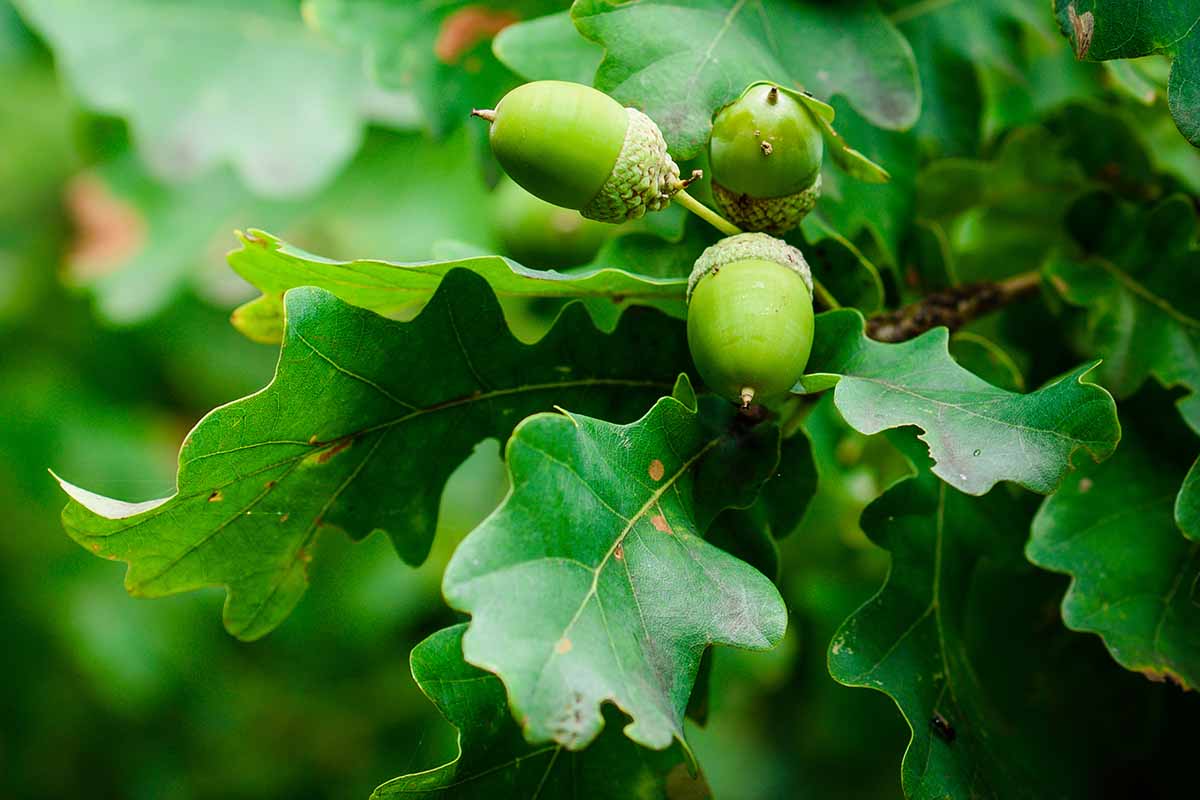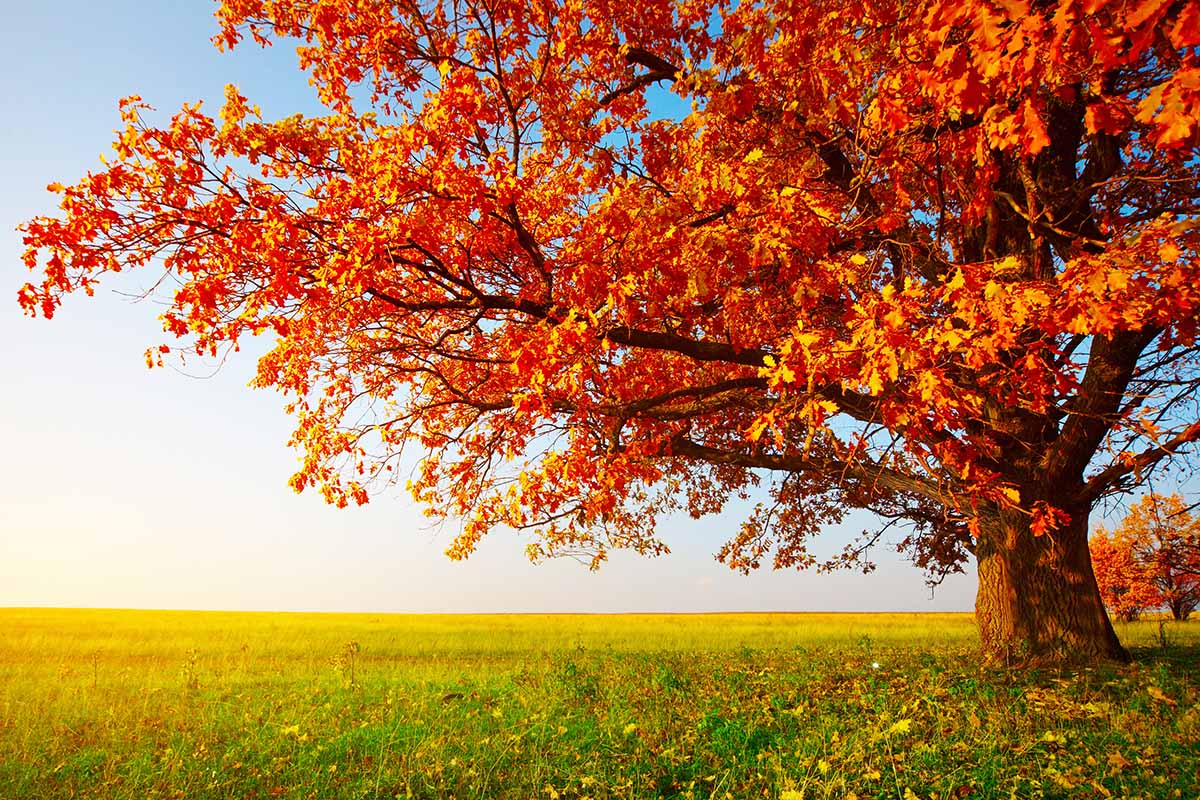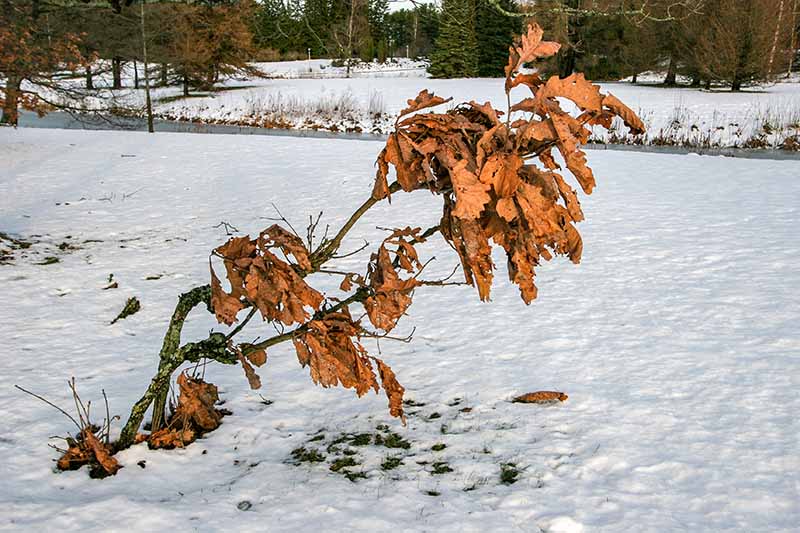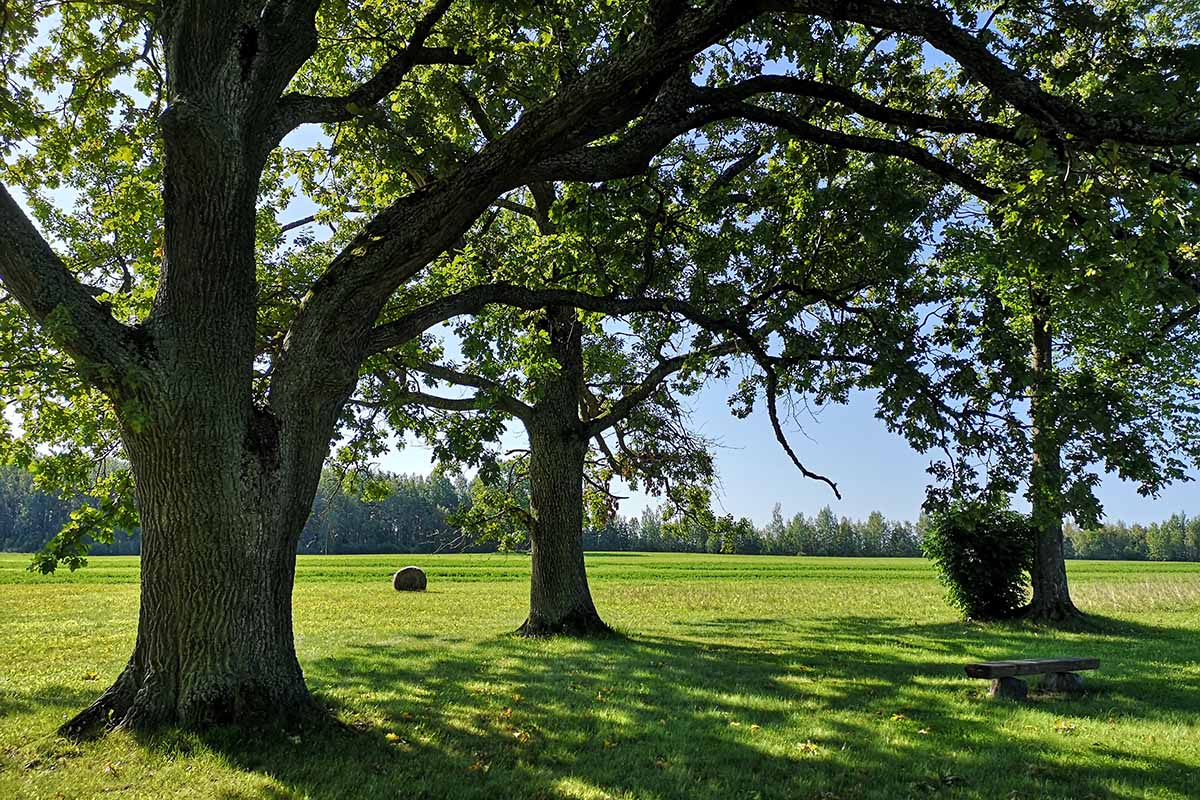We link to vendors to help you find relevant products. If you buy from one of our links, we may earn a commission. Quercus species are, in a few words, one of the best investments you can make in designing your landscape, and growing them is hardly rocket science. Reference our handy table of contents below to find the information you’re looking for, or if you’re like me and like to wander along the garden path, keep on reading and we’ll talk about all there is to know about growing oak trees.
What Are Oaks?
The Quercus genus encompasses a huge group of trees and shrubs. We’re talking in the neighborhood of 500 known species of oaks worldwide. Wowza, right? Because there is so much amazing variety among Quercus varieties for home gardeners, it’s impossible to write a comprehensive growing guide on every single species. Here, we’ll stick with the basics. But stay tuned for targeted guides to growing specific species and cultivars in the future as well. We’ve decided to focus on some of the more common species here that follow the same general growing rules. Don’t worry, if there are any notable exceptions to any of these guidelines, they are detailed below!
Red or White?
No, we’re not talking about wine here. Two general types of oak trees exist, the red and the white. The red oak tends to grow faster than the white, and will reach heights less impressive than those of white varieties. The bark on red Quercus, as well as the wood itself, is darker than that of whites and is roughly textured. White Quercus varieties have bark with deeper grooves, and their leaves have rounded lobes. These trees grow to very large sizes, and it’s unlikely that any gardener will see the full stature of a white oak they plant within their lifetime. But that’s no reason to skip planting them! You can figure out whether a specimen in your neighborhood is a red oak or a white one by examining the leaves. Red Quercus will have leaves with deeper, often pointed tips.
Cultivation and History
Which came first, the acorn or the oak? One of the most important trees in human history, the oak has been utilized widely by humans in the Northern Hemisphere since… well, for as long as there have been people. Quercus has a muddied history, as most ancient life forms do, but fossil evidence suggests that the genus found its start in North America. Since then, humankind has found uses for every bit of the oak tree. The wood is strong and resilient to rot and weathering, and it’s been put to use in any project that requires strong lumber. Ship masts, bows and arrows, furniture, wine barrels, tools, housing – Quercus is ideal for pretty much anything that requires the finest sturdy and resilient lumber. The acorns produced by oaks were a food source for many Indigenous people. Removing the hard outer shell exposes the edible stuff inside. It apparently doesn’t taste very good, or so I’ve read, but enough of it could be dried and ground to make a plain and slightly nutty flour that pairs well with wild game. Even the leaves have been used in making sauerkraut, wine, and tea. The tannins in oak leaves were utilized in many non-culinary areas as well, from tanning leather to making cosmetics and feeding animals. Oak trees in the modern day are used largely as landscape ornamentals. Many parks and wooded areas feature a variety of different types that offer shade and respite from the summer heat. Beyond these uses, Quercus trees are also vital to wildlife, and a host of species depend on oaks to survive. Adding more oaks to our landscapes and parks directly helps our local ecosystems, and that helps to strengthen the natural world everywhere.
Propagation
Your options for planting Quercus are relatively limited, and the cost of doing so can range from little to no cash exchanged and a few minutes of your time to huge investments of thousands of dollars. It all comes down to how patient you are, and when you’re dealing with oaks, patience comes with the territory.
From Seed
It all begins here, with a tiny little nut you can hold in your hand that can one day grow into a hundred-foot behemoth. Every oak has the same beginning, but it’s estimated that just one out of every 10,000 acorns will actually grow into a tree. That’s a lot of nuts, ain’t it? While ol’ Mother Nature relies on the potential of thousands of acorns to grow a single oak, you can have much better luck by finding some yourself and starting the process without the nuisance of squirrels and other critters tearing apart the oak tree’s work. When foraging for your own acorns you’ll be looking for nuts that have dropped to the ground. If the acorns are still on the tree, they’re not ready to be planted, and you could also damage the tree by removing them prematurely. This is a project that’s ideal to start in mid- to late autumn, though you can harvest your acorns a month or so beforehand if they’re viable. If you harvest acorns before you’re ready to sow, keep them somewhere cool and dry until you’re ready for them. You’re going to want to collect a good amount of acorns – I’d say at least 12 for every tree you want to plant. Make sure to leave plenty for the local wildlife! Keep two things in mind: The first is that Quercus trees don’t produce acorns every single year. On average, they will produce acorns every two to three years, while some white Quercus species will produce a large crop once every five years. If you haven’t found acorns at the park or in the woods, keep on walkin’ and you’re likely to find a tree that has produced a large crop. The second important factor when hunting for acorns is to try and select ones that have fallen from healthy-looking specimens. The stronger the tree, the stronger the seed. Try to avoid harvesting acorns from sickly or diseased trees to ensure you get the best of the best. Before we get too far along here, here’s a small checklist of items you’ll need for propagation:
AcornsContainer to fill with water and soak acorns inPotting mix and native soil (if planting in a container)Containers for cold stratifying your acorns (should be mostly airtight)Container for planting each acorn (should have drainage holes)Fencing for your Quercus if critters are a concernFertilizer (compost or manure works best for propagation)
After you’ve foraged your acorns, collected them, and brought them to your workspace, find an appropriately sized container that can hold enough water for the acorns to float in (you’ll see why this is important later). An empty five-gallon bucket is my preferred water receptacle, but a large bowl can work too. Fill it with water and dump in your acorns; this will be their home for 24 hours. If the acorns float after 24 hours, they are not viable and can be disposed of. Every acorn that sunk to the bottom is potentially a brand new oak tree waiting for its chance to grow! Like many plant species, acorns need a cold winter period to get their gears turning and ready for growing in the spring. We can lend the acorns that experience in a protected environment by cold stratifying our future oak trees. It’s a very easy process, plus you get to keep a bag of dirt and acorns in your fridge – everybody wins! Place some good quality potting mix in a resealable container and dampen it so that the medium is moist but not wet. If you grab a handful of it and squeeze it, it should clump together but should not expel water. I usually use a plastic baggie for this, but a glass container with a lid works in a pinch, and so will any container that you can close with a lid. The goal is to keep the potting mix sealed off and damp. Throw your acorns into the bag (or bags, if you’ve got a lot of acorns you’re stratifying), mix them up with that soil, and plop them into your fridge. They’re going to stay there for about six weeks, give or take a week or two, and you’ll want to check them occasionally to ensure they’re not too wet or dry and to monitor for signs of growth. What we’re looking for is the tiny little nub of a taproot emerging from each acorn. It’s a pretty neat-looking bit of fleshy growth, usually a pale green that reminds me of banana peppers. This tiny taproot is also sensitive, so be gentle. When the taproot starts growing, it’s time to plant your baby oak! You can plant each acorn in a small container or put it straight into the ground. I’ve always preferred planting in containers rather than directly into the ground, but I’ll go over both styles.
Container Sowing
When sowing in a pot, I recommend using a #1 size container, aka a six-inch pot. This is a good size for giving your oak plenty of room to grow without becoming root bound. I’ve used smaller size pots and they work, but I like the space and size of #1 pot for projects like this. Make sure your container has a drainage hole. I also like to use a mixture of about half potting mix and half native soil for propagating acorns. The native soil should be sourced from wherever you’re going to be planting your oak tree. This serves as a preview for what your soon-to-be-tree will be growing in. The less shock the seedling has at planting time, the better chance it has of growing big and strong. Sow your cold-stratified acorns at a depth of about half their diameter, and orient them so the taproot is growing down. Cover with soil, gently pat the soil firm, and water it well. Going forward you want the soil to be moist but never sopping wet. If there’s no danger of a hard or extended frost, you can keep your future Quercus somewhere semi-protected outdoors. I like to place all of my fostered plants against the outside foundation of my home. You could also choose to keep them inside in a sunny window until the danger of very cold temperatures has passed. In a short time you should see the first oak leaves sprouting from the soil. Let that oak keep on keepin’ on, and for those kept indoors wait until early spring to harden the young sapling off to outdoor weather conditions. As is the case with most seedlings, your goal is to slowly acclimate your plant by keeping it outside for increasing amounts of time starting with an hour, gradually increasing the duration outdoors over a week or two. After this period you can safely keep your Quercus outdoors permanently. If there’s a sudden cold snap, bring them back inside. Ensure these babies get morning sunlight but are also protected from the hottest, brightest afternoon sun. When the soil is workable and you’re past the last frost in your area, you can transplant your containerized oak seedlings into their new homes. As long as your babies are conditioned to the cold you can plant them. I’ve never had a loss from seasonably cold temperatures, but when the temperatures are in the low 20s or lower, I’ll favor caution and hold off on planting until it warms up a bit. Dig a hole twice as wide as the container and a little bit deeper, then carefully transplant the seedling into the hole. As a rule I tend to plant everything a little high – you want the top of your potted plant to be slightly higher than the grade of the soil it is being planted in. Keep the soil around your seedling watered but not wet, and watch your baby oak start to really grow! At these early stages the plants can easily put on a foot or two of growth each year.
In-Ground Sowing
When sowing directly in the ground, you can skip everything described above except for the part about cold stratifying. If you sow in the fall, Mother Nature will take care of this for you. When you’ve found the right spot for your oak tree, clear any surrounding vegetation like grass or other plants to a diameter of about 12 inches. I like to dig the hole to a diameter and depth of about six inches so your acorn has an easy time getting started. As outlined above, sow the acorn to a depth about twice as deep as the acorn is wide – that’s probably about two inches deep. Water well, and keep an eye on your babies until they start to show signs of life. In my experience the best time to directly sow an acorn is when they’re falling off of trees. If you plant in the fall, cold stratification will happen naturally, for spring-planted acorns, you’ll need to cold stratify them in the fridge as described above. For both planting methods, be sure to provide suitable protection for these tender saplings. Deer and rabbits are likely to demolish all of that soft green growth. I suggest using a physical barrier of some kind to keep animals out and away. Dog fencing zip-tied together or hardware cloth nailed to a wooden frame works great. This fencing should be something you can easily remove to check on the plant and to clear encroaching grasses and weeds.
From the Nursery
You can skip all of those directions and simply buy a potted specimen or one with burlap-wrapped roots from a nursery. Instant gratification! While you get a larger tree immediately, this option has risks attached to it. Quercus species are sensitive to damage to their roots, and they can stall development for as long as an entire growing season when they’re transplanted. Burlap-wrapped or balled trees are those that have their roots and soil wrapped in burlap or other coarse fabric. The covering is typically secured with wire, twine, or string, depending on the size of the specimen. The labor is also more difficult by an order of magnitude. But, if your best option is to buy a containerized or burlap-wrapped tree, there’s still a path to success. Look for a plant with a strong central leader and without damage to the bark. It should be clear of pests, and in the case of container plants, not root bound with roots circling or protruding from the pot. You can take a peek at the drainage holes of container-grown specimens to check the condition of the roots. If a pot has roots popping out the bottom, the oak’s probably root bound and less likely to be a prime plant. When you bring your containerized or burlap-wrapped plant home, dig a hole twice as wide as the container or root ball and one-and-a-half times as deep and backfill partway with the native soil.
Planting Container Specimens
Remove the oak from the container. If its roots are matted and tightly growing around the soil, carefully untangle them before planting. Minimize any damage you make here and be gentle. From here, it can be difficult to get the plant into the soil at the right height. It’s generally easier to fill the hole in with loose soil and scoop out a small crater, then work the soil into the disturbed roots until the tree stands mostly upright. Backfill and pat in place. If the roots are not matted and the soil in the container is loose, be very careful removing the plant from its container. You’re almost guaranteed to lose the loose soil, but your goal is to minimize that loss until you get the tree in the hole, while avoiding damaging the roots as well. Backfill and firm the soil up, and give it a drink.
Planting Burlap-Wrapped Trees
Remove any outer plastic and twine or wire that is securing the burlap in place. Carefully position the tree into the hole with the crown slightly above the soil line – you may need to add soil underneath the root ball to allow for settling. When it’s in position, cut away the burlap wrapper. Backfill with soil and tamp it down firmly to ensure there are no air pockets before watering well. In both cases you’re probably going to need to stake the tree after planting. Use a piece of bamboo or whatever strong, sturdy stake you’ve got handy, and gently tie the plant to the stake so it has some support until it grows a firm footing in the ground. If you’re working with a larger tree or the plant is significantly topheavy, you might need to use two or three stakes that work together to hold it upright so it never leans too far in one direction.
Tree Spade, Ho!
A tree spade isn’t a shovel you might pull out of the tool shed. It’s a specialized vehicle with a digging apparatus that can transplant adult trees. To see this thing in action, check out this charmingly dated video from an excellent company I’ve had the pleasure of working with directly. If you’ve got the means, you could opt for the highest level of instant satisfaction in the gardening world by buying a tree that’s already attained an impressive stature and having it installed directly where you want it. This is by far the most expensive option. Between the tree and the specialized labor required, you’re probably looking at something in the neighborhood of at least five thousand dollars. If this is an option you’re considering, contact a high-end landscaping business to find reputable work in your area. These organizations generally take care of everything and you’re only responsible for watering the tree after it’s been planted. Again, these experts will make sure you’re well prepared to handle the next few years until the oak is established. Any necessary labor or effort on your part is minimal! In all cases, apply a nice coating of compost or manure when planting the tree. A quarter-inch layer the size of the hole you dug is perfect. It’s possible to use synthetic fertilizer instead, but I don’t recommend it. If it’s your only option, use a 10-10-10 NPK balanced fertilizer at about three-quarters of the recommended application rate.
How to Grow
Oak trees want rich and loamy soils. Think about a forest floor and you’ve got the right kind of growing medium in mind. They can do well in more clay-heavy or sandy soil, but are hardly at their best in these conditions. Most Quercus species and cultivars cannot tolerate very wet or heavy soils, so if these are your conditions, consider other trees. Oaks like plenty of sun and are drought resistant once established. During the first year after planting, ensure your oak tree is getting a good drink of water once a week to help establish strong roots. One and a half to two inches of rain a week is ideal for new plantings – you can check how much rainfall you receive with a rain gauge. If you’re experiencing a drought, supplement its intake with long, deep drinks from the hose. Quercus species like regular fertilization, but it doesn’t need to be frequent. In my experience a healthy layer of compost added around the drip line once every year in the spring is sufficient.
Growing Tips
Water regularly after planting to encourage healthy root development.Install a small fence around new plantings to prevent very young leaves from being munched on.Young bucks like to tear up developing trees in the landscape with their antlers. Really, set up a fence!The first year or two are of extreme importance for growing oaks, so keep them watered well, fertilized, and watch for signs of stress.
Pruning and Maintenance
Oak trees under three years of age should never be pruned, and Quercus should never be pruned during the summer to avoid health risks. That’s a very important rule to keep in mind. After the trees have become established and are at least three years old, you can begin to consider pruning. They don’t generally need much, and you only need to make two basic cuts. Always use a set of bypass pruners for pruning to ensure clean cuts with minimally damaged tissue. The first cut you’ll be making is on any branch that’s growing straight up towards the crown. Oak branches should grow laterally, not upwards. Removing these limbs prevents crowding, and branches that grow too upright can be damaged from heavy snow. The second pruning cut is for branches that are rubbing together. Every time you note this condition, you want to remove the weaker branch that’s crossing over another stronger one. If you have questions, ask in the comments below (ideally with a photograph to help!), or consult a professional. If you’re unsure of what you’re pruning, don’t prune it at all! A lot of trees are very forgiving of pruning mishaps and mistakes, but oaks can be temperamental about mis-snipped branches. You’ll likely have some raking to do in the fall. But some species of Quercus will hold onto their leaves throughout the entire winter until new spring buds take their place. Do not remove dead leaves from an oak tree! These leaves are an important source of nutrition for the tree in the springtime, and they protect sensitive leaf buds from cold weather. They are also helpful for wildlife over the winter and in the early springtime. Leave the leaves alone!
Herbivores
These pests pose a danger in the first few years of your tree’s life, but once the tree is of sufficient size it will laugh off every attempt by these predators to damage it. You can find others elsewhere, and of course you can find acorns from trees near your home. I believe the acorn sowing method is the best for adding an oak tree to your property, though it’s time-consuming, but these trees are available for those without access or the desire to grow something from seed.
Bur Oak
One of the largest options you can find, the bur oak (Q. macrocarpa) is a white oak species that will reach an impressive 100 feet in height. You can grow this gorgeous, stately tree in Zones 3 through 8. Its bark is distinctive and provides year-round interest all by itself. It produces large masts of acorns and is a favorite food source for wildlife. It’s definitely worth your time – and your money – to add this tree to your landscape. Bur Oak Specimens available in a variety of container sizes are available from Nature Hills Nursery.
Northern Red Oak
This is a very popular and common oak tree, and is likely what comes to mind when many people think of an oak. Viable in Zones 3 to 8, the northern red oak (Q. rubra) grows quickly (for an oak!) and offers gorgeous foliage in the fall. How gorgeous? Imagine the prettiest and richest ruby red leaf you can imagine, and then double it. That gorgeous. This species usually tops out at around 60 feet in height. These trees can also be planted closer together than white Quercus, somewhere in the 15-foot range from center distance. Northern Red Trees eight to nine feet in height in #15 containers are available from Nature Hills Nursery.
Pin Oak
Growing faster than most species of Quercus, the pin oak (Q. palustris) is another very popular option. It reaches a height approaching 80 feet but is more narrow than other types. This makes it a great tree to plant in small groups throughout the landscape. Pin oaks are less exuberant in their fall color presentation and will feature bronze and brown leaves, but those subdued hues make the other colors in the autumn landscape stand out that much more. Pin Oak Give this fast-growing oak a shot if you live in Zones 4 through 8. Plants are available in different sizes from FastGrowingTrees.com.
Southern Live Oak
The southern live oak is the right pick for people living in warmer regions and it’s comfortable in Zones 8 to 10. Q. virginiana is an icon in the tree world, the first image that comes to mind when imagining a tree on an oppressively muggy day in the deep South, covered in Spanish moss. Except a height maxing out around 80 feet, with an impressive spread approaching a 90-foot distance in the canopy. Southern Live Trees are available in #1 and #5 containers from Nature Hills Nursery.
Swamp White Oak
Q. bicolor is a personal favorite of mine, but more importantly, a valuable addition to any landscape within a suitable environment in Zones 4 to 8 for hundreds of years. While the swamp white oak will likely reach a maximum height of about 60 feet it is very slow-growing. The bark peels slightly in the winter and adds a different texture to the otherwise gray landscape. Its bark is roughly grooved and catches the snow and the ice differently than trees with smoother bark in your landscape. Swamp White Plants are available in a variety of sizes in containers ranging from one to 22 gallons from Nature Hills Nursery. For a smaller option, Q. bicolor ‘Bonnie and Mike,’ aka Beacon is an upright cultivar with a mature height of 30 to 35 feet and a spread of only 12 to 16 feet. ‘Bonnie and Mike’ You can find three- to four- and four- to five-foot trees available from FastGrowingTrees.com.
Managing Pests and Disease
Luckily, the bigger animals that might harm your oak are only a threat for a short period of time. By the time your oak reaches a strong and stable size after a few years of growth, these animals would have a hard time causing it any trouble.
Rabbits
Rabbits enjoy stripping young Quercus bark and snacking on tender leaves. Anything that keeps rabbits away will work on your oak trees, but a small barrier or fence is by far the best option to protect your tree from these tiny herbivores.
Deer
Deer will likewise munch on leaves and bark on young Quercus specimens, but young bucks seem to love using oak trees as a place to rub their antlers and mark their territory. A cage placed around the tree, or just around the trunk itself, usually provides sufficient protection. Or you can build a deer fence. Stinky deterrents might work, but have an annoying requirement in that they must be reapplied often, particularly after it rains.
Insects
Most of the insect issues your Quercus may face aren’t likely to do much damage by themselves, and are relatively benign. In fact, most of the insects that may affect oak trees are important parts of the local ecosystem. Perhaps it’s counterintuitive, but the best treatment for most insect issues is no treatment at all. Wait for a natural predator to discover this important food source and take care of the problem for you!
Galls
Rather than being a sign of disease, oak galls are a reaction to certain insects, typically predatory wasps, and aren’t in and of themselves very dangerous to your tree. In the past, I have had friends and family ask me about these with reference to pests, so I thought it might make sense to include here. These look like round growths typically attached to the leaves of trees, ranging in the size from that of your pinky nail to a golf ball. The galls provide the insects inside with a degree of protection from pesticides, so your best bet… yep, do nothing. Galls are very, very rarely a serious issue in Quercus and can be considered a natural element of their presence in the yard. Another type that may be caused by a fungal pathogen is also described below.
Oakworms
What a beautiful pest! Oakworms (Anisota) are very attractive caterpillars that feed on oak tree leaves, but you’re in luck – these caterpillars are native to the United States and pose no lasting harm to your Quercus. Consider their presence a happy part of your tree’s life cycle, because they will likewise attract natural predators like birds and larger insects. Sit back and enjoy the show.
Disease
Disease is likely the most serious issue your Quercus might suffer from, but it’s something you’re unlikely to encounter as long as you’ve got a healthy tree. Of course, as oak trees get on in age – we’re talking trees that are decades old and older – they begin to decline and become more prone to experiencing the ravages of aging, and all that entails. If you’ve got a mature tree your best bet is to contact a professional who can diagnose and treat disease on a large scale. Some things are out of the control of homeowners! Interestingly, there are very few recommended treatments for most oak diseases. They are considered natural parts of the tree’s life cycle and it’s typically safe to allow them to run their course. If you have mature trees that are displaying serious signs of decline, you can record what your tree is experiencing in your gardening journal and then consult a professional arborist who can remedy the situation or make recommendations for removal.
Oak Anthracnose
Anthracnose is a fungal disease caused by Apiognomonia errabunda that typically doesn’t cause a lot of damage to healthy, vigorous trees. You’ll generally see signs of infection during mild, wet weather. Dark brown to black blotches on the leaf margins and along the veins appear water-soaked – eventually turning gray and papery. Typically, anthracnose only causes cosmetic damage in healthy, established trees. During periods of prolonged wet weather early in the growing season, damage can be severe, particularly in young specimens or those that lack vigor. Prue and discard affected foliage and branches, and remove fallen leaves in autumn to prevent the fungus from overwintering.
Tubakia Leaf Spot
Formerly known as actinopelte leaf spot, this disease is usually encountered late in the season, in July or August. You can identify this leaf spot disease by the… well, the spots on the leaves. They are typically brownish or reddish-brown and of various sizes, not dissimilar to anthracnose. This disease chiefly causes only cosmetic damage and since it doesn’t present itself as a problem until late in the year, it can typically be ignored. Severe cases can cause early defoliation. Caused by Tubakia dryina, previously classified as Actinopelte dryina, the fungal pathogens overwinter in dead or dying wood.
Bacterial Leaf Scorch
A disease readily identified by the browning edges of your Quercus leaves, bacterial leaf scorch is caused by Xylella fastidiosa. It’s typically seen in periods of prolonged drought. It’s not typically deadly and is a disease the tree can shrug off when it regains its vigor later in the season, or in the subsequent one. Ensuring your trees are irrigated during droughts and fertilized annually is the best prevention for diseases like this one.
Hypoxylon Canker
Dead lesions on limbs, branches, and the trunks of your trees serve as common signs of this fungal disease, caused by Hypoxylon atropunctatum. Severe cases may cause white sections of rot to develop on the wood of your tree. The pathogen attacks when trees are drought stressed, physically damaged, or otherwise unhealthy. This disease mostly impacts red oaks, and it can cause serious damage as the rotted out sections succumb to structural collapse and threaten the integrity of your tree – and any cars parked beneath rotting limbs. Your best bet here is to prune out infected tissue when it’s first encountered. I’m usually an advocate for leaving dead wood on trees since it’s an ecologically integral but very uncommon feature in our gardens. But hypoxylon cankers should really be removed when they’re first noticed. As there is no cure, severely damaged trees should be removed to prevent spread to surrounding oaks. Consult a local arborist to identify these cankers and remove the affected branches.
Oak Tree Blister
A funky-looking leaf with blistered or bubbled sections is a sign of oak tree blister. This is an issue typically encountered in very wet springs, and while the leaves might be a little ugly and the tree may drop the infected leaves, it’s not a long-term health issue. Caused by the fungus Taphrina caerulescens, there is no recommended treatment for oak tree blister except to wait for it to pass.
Pine-Oak Gall Rust
Galls will form on stems and branches when this disease is present, but these are not the same galls as those mentioned above, which are created by predatory wasps. Typically woody and vaguely round, these galls remind me of the shape of an amoeba. Is “amoebish” a word? It is now. Pine-oak galls look amoebish. The name of these galls hints at the fact that this rust is a fungal species called Cronartium quercuum f. sp. banksianae that spreads from pines to oaks. No recommended treatment exists, but you can easily identify symptoms in the springtime when the galls start to turn yellow.
Best Uses
All varieties of Quercus generally become enormous trees, so they’re best suited in areas where they can spread out their canopy with room to fill out. These are excellent trees to use when planning ahead for shade coverage in your home or yard. Quercus is an ideal type of tree to place in a park or public space where everyone can enjoy the shade it offers. It’s likewise one of a handful of trees perfectly suited for restoring the natural diversity of an area. Quercus species grow native across all of North America and any cultivated additions added to their ranks will bolster the wildlife in the area. Lastly, you may be familiar with the Greek proverb that states, “A society grows great when old men plant trees whose shade they know they shall never sit in.” Quercus specimens take a long time to really fill out and offer all of their many benefits, but that doesn’t mean we shouldn’t be planting them anyway. I can’t think of a better gift for children, grandchildren, and beyond, than a fresh new canopy of oak leaves to enjoy when we’ve all moved on to the big show. Don’t hesitate, plant! Most importantly, we’ve established that the best time to plant an oak is yesterday, and the second-best time is today, so get out there, get your tools and your garden hat, and start planting! Please leave your comments below – I love seeing anything you’ve got to share and look forward to answering any questions you may have! Looking for more growing guides that will help you to add shade trees and options with beautiful fall color to your landscape? Check out these next:
How to Plant and Care for a Chinkapin Oak TreeHow to Grow and Care for Maple Trees13 of the Best Trees and Shrubs for Orange Fall Color
